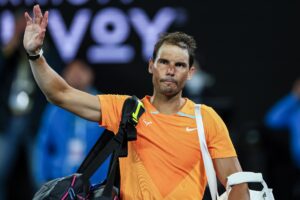Last weekend, Roger Federer literally went where no man has gone before, by becoming the first male tennis player to reach the landmark of 20 Major victories. Of course, Federer has achieved many remarkable things before. Only last summer, he became the first man to win eight Wimbledon singles titles, taking him past his own hero, Pete Sampras, and Britain’s 19th century tennis great, William Renshaw, who both won seven Wimbledon singles titles apiece. However, there is something extra-special about Federer reaching 20 Major wins. For one thing, it means that in his now 20-year career he averages one Grand Slam victory for every year that he has been a professional. More importantly, it means that he now stands alone in the tennis pantheon and belongs to the most exclusive sporting club of them all – the immortals, for want of a better word, who so completely transcend their sport that their achievements rank among the greatest human achievements in any field.
Tennis first. Of course, Federer is not the first tennis player to require all his hands and feet to count up his Major victories. Three women – Margaret Court (with 24 Grand Slams), Serena Williams (23) and Steffi Graf (22) – got there before him and still rank, in purely numerical terms, above him. However, the basic difference between men’s and women’s tennis, namely that in Grand Slam events men play five-set matches whereas women only play three-setters (a situation that writers such as Matthew Syed have rightly said exposes the fundamental and damaging sexism at the heart of tennis), means that Federer must rank more highly than his female rivals. Quite simply, he played a lot more tennis to win his 20 Majors than Court, Williams or Graf ever did.
Roger Federer’s Place in the Sporting Pantheon
Roger Federer’s only genuine rival as the greatest tennis player of all time is the man who watched him win in Melbourne last week and even took a picture to capture the moment, Australia’s own “Rocket” Rod Laver. Laver may only have won 11 Majors, but eight of those were won in just two years (1962 and 1969) when he completed genuine (i.e. calendar year) Grand Slams. Only one other man, Don Budge, has ever completed a genuine Grand Slam and he only did it once (in 1938). Even more impressively, the seven-year gap between Laver’s two Grand Slams was because, having turned professional after winning the first of them, he was then unable to compete in the sport’s greatest tournaments again until tennis went fully professional (or “Open”) in 1968. Tennis historians can only speculate as to how many more Majors Laver would have won had he not been kept away from the Slams for so long, but it is a safe assumption that it would have been a lot more than 11. Nevertheless, the currency of sport is ultimately cold, hard victory rather than fuzzy imagining, and so, as Laver himself graciously admitted last weekend, Federer can rightly be regarded as the greatest tennis player of all time.
Where, though, does that put Federer in the overall sporting hall of fame, where the great champions of all sports are lined up and ranked alongside each other? Ultimately, of course, no such institution exists or could exist, as it is virtually impossible to compare even the greatest achievements in one sport with those in another sport, especially where the sports being compared are so completely different (for example, tennis and rugby). Having said that, however, there is one quality that the very greatest sportsmen, like the very greatest artists or scientists, all have in common, and that is the sheer longevity of their careers.
There are many qualities and attributes that can be used to measure human achievement, including in sport, but I genuinely believe that longevity – put simply, the sheer length of time that a career lasts – is both the fairest and best measurement. It must be emphasised that it is not just longevity for longevity’s sake. It must be longevity that is accompanied, almost every step of the way (or every day, month and year), by victory. It is perhaps the single greatest sporting cliché of all that winning is easy, but what is really hard is winning again and again and again. For one thing, it presupposes that the sportsman or woman in question enjoys a relatively injury-free career, or at least that they recover from injury quickly and completely. For another, it shows that they possess and retain perhaps the single greatest quality evident in any long-standing human achievement, which is usually (especially in sport) called “hunger” or “desire” but might more accurately be called “the ability to endure”. And finally, maintaining a level of excellence in their performance over such a long period (as in Federer’s case, sometimes over several decades) allows them to experience what might be called different “periods”, or “ages”, in their careers.
The idea that someone might experience several different periods or ages in their careers is commonplace in art but is rarely applied to sport. The very greatest artists go through radically different but equally important stages of their career as they build up an overall body of work. Examples would include the different periods of Picasso’s career, which usually correspond to the use of a particular colour in his work (especially his “blue” and “rose” periods); the evolution of Shakespeare’s writing from early works to mature masterpieces and ultimately the sublime “Late Plays”; and The Beatles’ remarkable, warp-speed transformation from the world’s first boy-band to the greatest rock band ever in just seven years.
With the very greatest sportsmen, such as Roger Federer, it is also possible to identify different stages or periods in their careers, precisely because their careers are so long. Federer himself has gone from a precocious youth who could not immediately translate his obvious talent into achievement (which is probably the hardest achievement of all, in any field) to an “imperial” or nearly “unbeatable” phase (roughly between 2003 and 2008) and finally to a “mature” or “late” stage in the last year or so when most tennis observers would argue that he has actually improved his game, in particular his backhand, to the point where he might just be better now than he ever was before.
It is his remarkable longevity, coupled with his near-constant evolution, while always making sure that he won and didn’t just come close to winning, that puts Federer in the front rank of all sportsmen or women. Indeed, I would argue that there are only really a handful of other sportsmen (literally, just about five) who have enjoyed similarly long, varied and hugely successful careers. They are: Muhammad Ali, three-time world heavyweight boxing champion between 1963 and 1978 (and, like Rod Laver, Ali was robbed of what would probably have been the best years of his career, when he was banned from boxing for refusing to be drafted to fight in Vietnam); Don Bradman, the astonishing Australian cricketer, whose batting average of 99.94 is nearly 40 runs higher than the next batsman on the all-time list; Pele, who won the World Cup (arguably the greatest prize in all of sport and not just football) three times; Jack Nicklaus, whose record of 18 Major wins in golf has withstood even the onslaught of Tiger Woods; and, finally, Tom Brady, whose five Superbowl wins over 15 years (and that could rise to six this weekend) make him the greatest quarterback of all time, in a position that is often said to be not only the most difficult in American football but the most difficult in all of sport. Like Federer, these five men have enjoyed remarkably long careers (on average, about 15 years or so), their ability evolved and often improved over time and, most importantly, they kept on winning.
What really puts into perspective their achievements is a brief consideration of those truly great sportsmen and women who do not make that most exclusive of clubs, including the aforementioned female tennis greats such as Margaret Court and Serena Williams, and sportsmen of the calibre of Michael Jordan, Diego Maradona and Usain Bolt, who all achieved remarkable things but usually only did so for about a decade or so at most. They are all unequivocally great, but they are not all-time great, and perhaps the key word in that phrase is “time”, the sea we all swim in but which the very greatest of us – such as Federer, Ali and Brady, not to mention Shakespeare, Picasso and Einstein – almost walk upon.
Main Photo:






